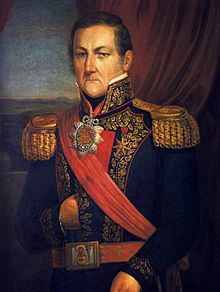
Back خوان مانويل دي روساس Arabic خوان مانويل دى روساس ARZ Juan Manuel de Rosas AST Juan Manuel de Rosas Aymara Xuan Manuel de Rosas Azerbaijani Хуан Мануэль дэ Росас Byelorussian Juan Manuel de Rosas Catalan Juan Manuel de Rosas Czech Juan Manuel de Rosas German Χουάν Μανουέλ δε Ρόσας Greek
Juan Manuel de Rosas | |
|---|---|
 Contemporary portrait of Rosas wearing the full dress of a brigadier general, c. 1850 | |
| 13th and 17th Governor of Buenos Aires Province | |
| In office 7 March 1835 – 3 February 1852 | |
| Preceded by | Manuel Vicente Maza |
| Succeeded by | Vicente López y Planes |
| In office 6 December 1829 – 5 December 1832 | |
| Preceded by | Juan José Viamonte |
| Succeeded by | Juan Ramón Balcarce |
| Personal details | |
| Born | Juan Manuel José Domingo Ortiz de Rozas y López de Osornio 30 March 1793 Buenos Aires, Viceroyalty of the Río de la Plata, Spanish Empire |
| Died | 14 March 1877 (aged 83) Southampton, United Kingdom |
| Resting place | La Recoleta Cemetery, Buenos Aires |
| Nationality | Argentine |
| Political party |
|
| Spouse | |
| Children |
|
| Signature |  |
| Military service | |
| Battles/wars | British invasions of the River Plate Argentine Civil Wars Desert Campaign (1833–1834) Tarija War French blockade of the Río de la Plata Anglo-French blockade of the Río de la Plata Platine War Uruguayan Civil War Battle of Caseros |
Juan Manuel José Domingo Ortiz de Rozas y López de Osornio (30 March 1793 – 14 March 1877), nicknamed "Restorer of the Laws",[A] was an Argentine politician and army officer who ruled Buenos Aires Province and briefly the Argentine Confederation. Although born into a wealthy family, Rosas independently amassed a personal fortune, acquiring large tracts of land in the process. Rosas enlisted his workers in a private militia, as was common for rural proprietors, and took part in the disputes that led to numerous civil wars in his country. Victorious in warfare, personally influential, and with vast landholdings and a loyal private army, Rosas became a caudillo, as provincial warlords in the region were known. He eventually reached the rank of brigadier general, the highest in the Argentine Army, and became the undisputed leader of the Federalist Party.
In December 1829, Rosas became governor of the province of Buenos Aires and established a dictatorship backed by state terrorism. In 1831, he signed the Federal Pact, recognising provincial autonomy and creating the Argentine Confederation. When his term of office ended in 1832, Rosas departed to the frontier to wage war on the indigenous peoples. After his supporters launched a coup in Buenos Aires, Rosas was asked to return and once again took office as governor. Rosas reestablished his dictatorship and formed the repressive Mazorca, an armed parapolice that killed thousands of citizens. Elections became a farce, and the legislature and judiciary became docile instruments of his will. Rosas created a cult of personality and his regime became totalitarian in nature, with all aspects of society rigidly controlled.
Rosas faced many threats to his power during the late 1830s and early 1840s. He fought a war against the Peru–Bolivian Confederation, endured a blockade by France, faced a revolt in his own province and battled a major rebellion that lasted for years and spread to five northern Argentine provinces. Rosas persevered and extended his influence in the provinces, exercising effective control over them through direct and indirect means. By 1848, he had extended his power beyond the borders of Buenos Aires and was ruler of all of Argentina. Rosas also attempted to annex the neighbouring nations of Uruguay and Paraguay. France and Great Britain jointly retaliated against Argentine expansionism, blockading Buenos Aires for most of the late 1840s, but were unable to halt Rosas, whose prestige was greatly enhanced by his string of successes.
When the Empire of Brazil began aiding Uruguay in its struggle against Argentina, Rosas declared war in August 1851, starting the Platine War. This short conflict ended with Rosas being defeated and absconding to Britain. His last years were spent in exile living as a tenant farmer until his death in 1877. Rosas garnered an enduring public perception among Argentines as a brutal tyrant. Since the 1930s, an authoritarian, anti-Semitic, and racist political movement in Argentina called Revisionism tried to improve Rosas' reputation and establish a new dictatorship in the model of his regime. In 1989, his remains were repatriated by the government in an attempt to promote national unity, seeking to rehabilitate Rosas and pardon military personnel convicted of human rights abuses. Rosas remains a controversial figure in Argentina in the 21st century; he was represented on the 20 Argentine peso bill until 2017.
- ^ Claudia Peiró (20 June 2020). "Pedro, el hijo secreto de Manuel Belgrano que fue adoptado por Juan Manuel de Rosas". Infobae (in Spanish).
- ^ Sáenz Quesada, María (2012). Mujeres de Rosas. Sudamericana.
- ^ Sala de Representantes de la Provincia de Buenos Aires 1842, p. 3.
- ^ Lynch 2001, p. 19.
- ^ Lynch 1981, p. 9.
- ^ Hudson 1918, pp. 107–108.
Cite error: There are <ref group=upper-alpha> tags or {{efn-ua}} templates on this page, but the references will not show without a {{reflist|group=upper-alpha}} template or {{notelist-ua}} template (see the help page).